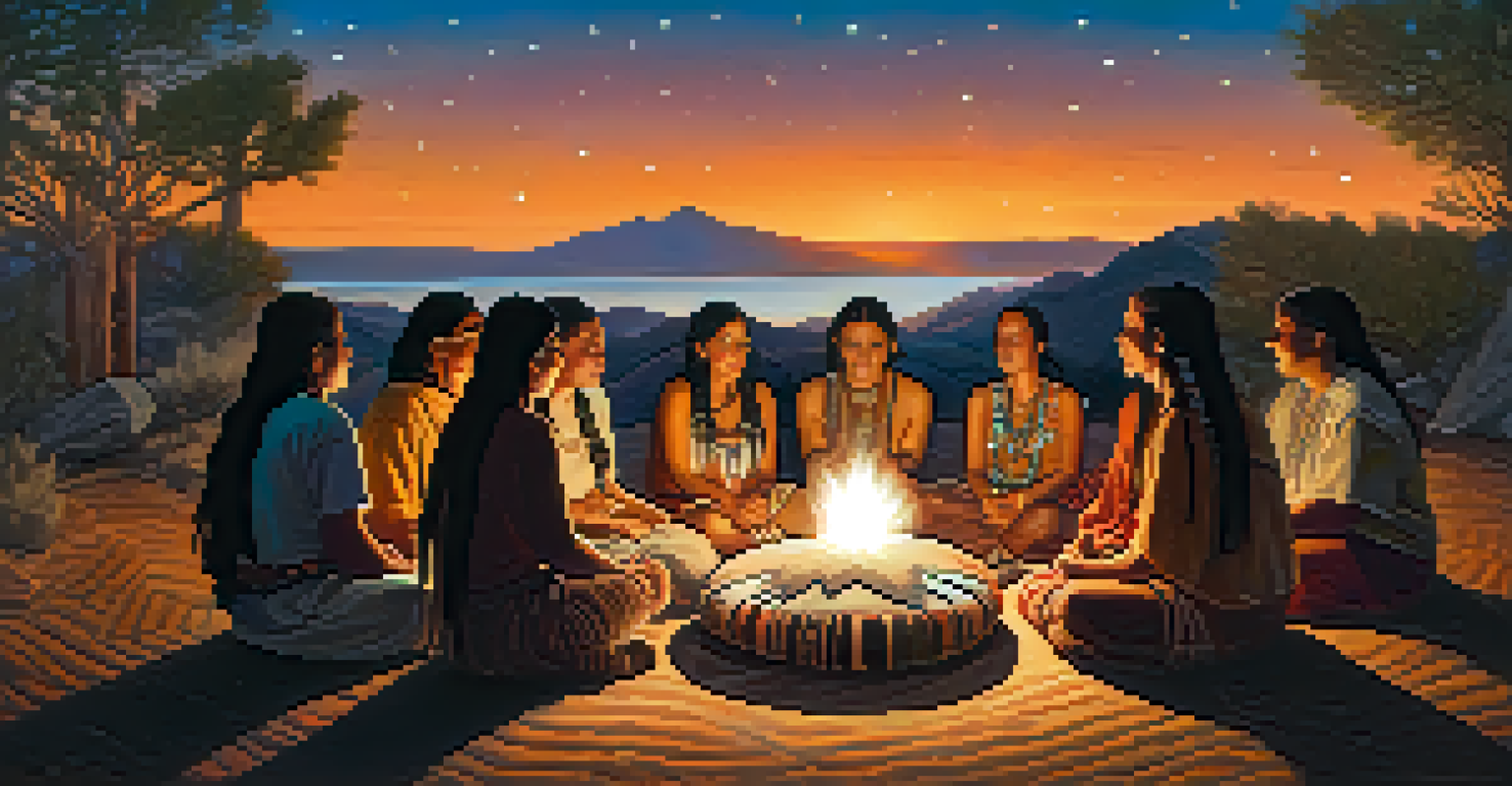Peyote: A Catalyst for Cultural Preservation Among Tribes

Understanding Peyote and Its Cultural Significance
Peyote is a small, spineless cactus native to the southwestern United States and Mexico. It contains mescaline, a psychoactive compound that induces altered states of consciousness. Beyond its psychoactive properties, peyote holds deep spiritual significance for various Native American tribes, serving as a bridge to their ancestral traditions.
The use of peyote is not just a personal journey; it’s a collective experience that binds us to our ancestors and our community.
Many tribes, such as the Huichol and Lakota, use peyote in religious ceremonies, where it facilitates connection with the divine. These rituals often incorporate songs, prayers, and communal gatherings, reinforcing the importance of community and shared identity. The experience of consuming peyote is not merely individual; it is about collective healing and cultural reaffirmation.
As a culturally sacred plant, peyote is more than just a substance; it represents resilience and continuity of Native traditions. The ceremonies surrounding its use are vital for passing down stories, teachings, and practices from one generation to the next, acting as a living library of cultural heritage.
Peyote and the Preservation of Language
Language is a crucial element of cultural identity, and peyote ceremonies often involve traditional languages that are at risk of fading away. By conducting rituals in their native tongues, tribes help maintain their linguistic heritage, ensuring that the meanings and nuances of their cultures remain alive. This practice fosters a sense of pride and belonging among younger generations, encouraging them to learn and speak their ancestral languages.

Moreover, the stories shared during these ceremonies often contain rich vocabulary and expressions unique to the culture. As participants engage in these sacred narratives, they reinforce the importance of language as a vessel for cultural knowledge and identity. This communal experience not only keeps the language alive but also enriches the collective memory of the tribe.
Peyote's Cultural Significance
Peyote serves as a spiritual bridge for Native American tribes, reinforcing their ancestral traditions and community identity.
Thus, peyote serves as a conduit for cultural preservation, allowing tribes to revitalize their languages and teach them to future generations. In this way, peyote does not just support personal spiritual journeys; it plays a pivotal role in safeguarding an entire cultural legacy.
The Role of Peyote in Traditional Healing Practices
For many tribes, peyote is integral to traditional healing practices. Shamans or healers often use it in ceremonies to diagnose and treat physical and spiritual ailments, believing that it allows them to connect with spiritual realms. This holistic approach intertwines the physical, emotional, and spiritual aspects of health, embodying a comprehensive understanding of well-being.
Language is the roadmap of a culture. It tells you where you are from and where you are going.
During these ceremonies, participants may experience profound insights or emotional releases that contribute to their healing process. The communal aspect of these rituals fosters a supportive environment, where individuals can share their struggles and receive encouragement from their peers. This sense of belonging can be just as healing as the peyote itself.
By integrating peyote into their healing practices, tribes not only address individual health needs but also reinforce their cultural identity. The continuation of these practices serves as a powerful reminder of their resilience and the importance of maintaining traditional knowledge in a rapidly changing world.
Peyote and the Reaffirmation of Tribal Identity
The use of peyote in rituals serves as a powerful reaffirmation of tribal identity. As members participate in ceremonies, they reconnect with their roots and express solidarity with their community. This shared experience fosters a sense of belonging and pride, particularly in a world where Indigenous identities have often been marginalized or misunderstood.
Peyote gatherings can be seen as cultural celebrations, where traditional music, dance, and art come together, showcasing the vibrancy of Native cultures. These events not only strengthen communal bonds but also educate younger generations about their heritage, ensuring that cultural practices are not lost to time.
Language Preservation Through Rituals
Peyote ceremonies help maintain traditional languages, fostering pride and belonging among younger generations.
In this way, peyote acts as a symbol of resistance against cultural erosion. By holding onto their traditions and beliefs, tribes assert their right to exist and thrive, showcasing their unique identities in the face of adversity.
Legal Challenges Surrounding Peyote Use
While peyote holds immense cultural significance, its legal status has been contentious. In the United States, the Controlled Substances Act classifies peyote as a Schedule I drug, restricting its use outside of recognized religious ceremonies. This legal framework can create obstacles for tribes seeking to maintain their traditional practices, as they navigate the complexities of federal and state laws.
Despite these challenges, some tribes have successfully fought for their rights to use peyote in religious contexts. Legal cases have highlighted the importance of preserving cultural practices, allowing tribes to continue their rituals without fear of prosecution. This ongoing struggle reflects the broader fight for Indigenous rights and cultural preservation.
As the conversation about peyote evolves, it serves as a reminder of the need for respectful dialogue around Indigenous practices. Advocating for legal protections ensures that tribes can continue to honor their traditions and pass them down to future generations, safeguarding their cultural heritage.
Peyote's Role in Modern Indigenous Movements
In recent years, there has been a resurgence of interest in peyote within modern Indigenous movements. As tribes seek to reclaim their cultural identity and autonomy, peyote serves as a unifying symbol of resistance and revival. Activists often emphasize its role in spiritual and cultural practices, advocating for its recognition and protection under the law.
These movements not only focus on the preservation of traditional practices but also address broader social and environmental issues facing Indigenous communities. By highlighting the interconnectedness of culture, spirituality, and activism, peyote becomes a central element in the fight for Indigenous rights and sovereignty.
Legal Challenges for Peyote Use
Despite its cultural importance, peyote's legal status poses challenges for tribes striving to maintain their traditional practices.
Through this lens, peyote represents more than a plant; it embodies resilience, cultural pride, and a commitment to future generations. By recognizing its significance, modern Indigenous movements can foster a renewed sense of identity and purpose.
Conclusion: The Future of Peyote in Cultural Preservation
As we look to the future, the role of peyote in cultural preservation remains vital for many Native American tribes. Its use in spiritual ceremonies not only reinforces cultural identity but also promotes healing and community cohesion. The ongoing efforts to protect peyote and its significance highlight the importance of respecting Indigenous traditions.
Continued advocacy for legal protections and recognition of traditional practices will be essential in ensuring that peyote remains a catalyst for cultural preservation. By working collaboratively with Indigenous communities, society can help foster an environment where these traditions can thrive.

Ultimately, the story of peyote is one of resilience and hope. As tribes continue to embrace their cultural heritage, they pave the way for future generations to connect with their roots, ensuring that the legacy of peyote endures.